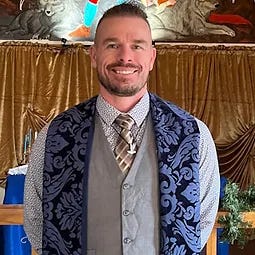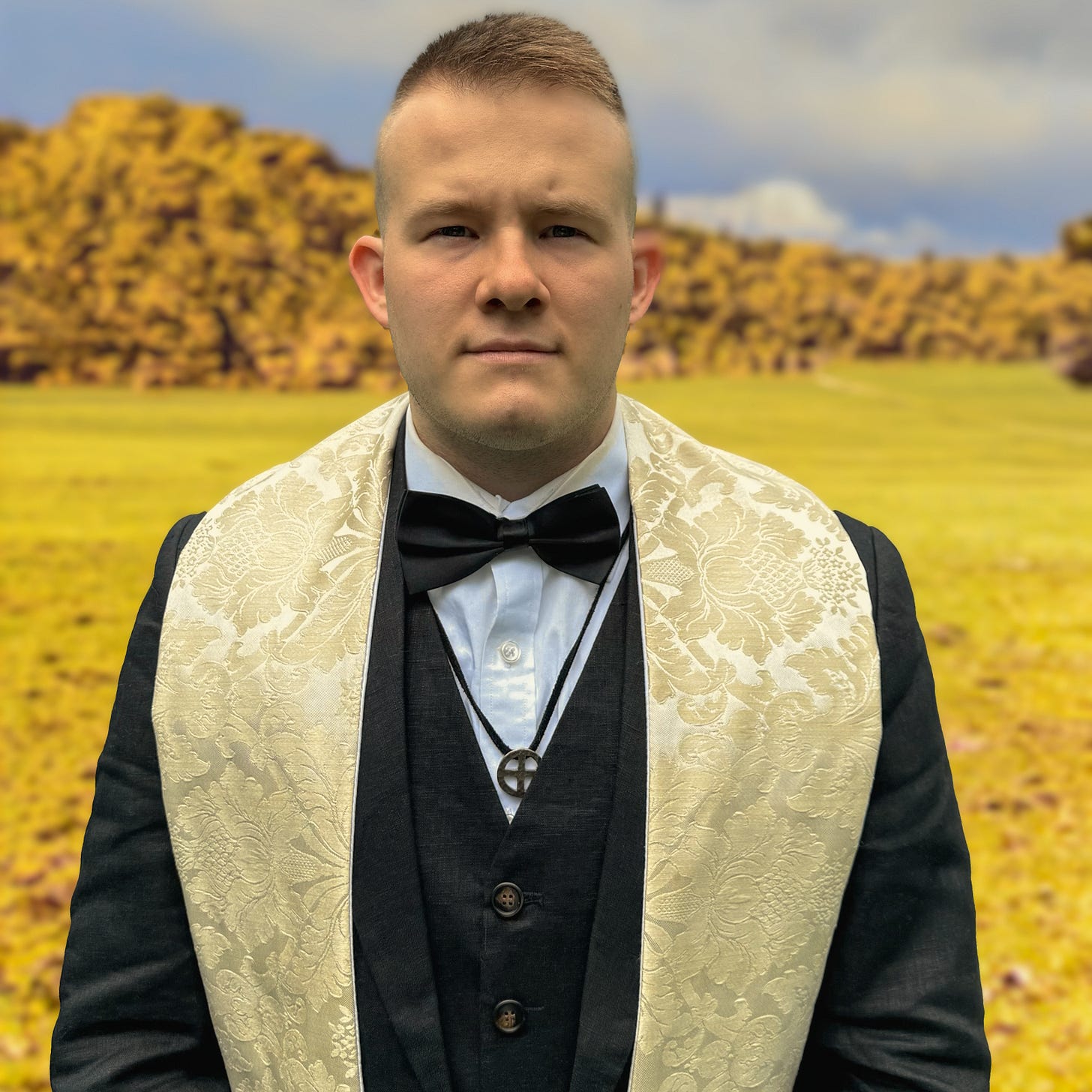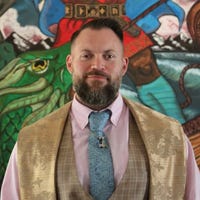Words from the Allsherjargoði
Victory is in the air! July saw amazing Sigrblótar at all 4 Hofs, plus Sigrheim. We have had a surge in new members joining, as well as interested people attending events. The Folk are waking up and coming home to our ancestral faith. I am proud of what all we have accomplished in the first 30 years of the AFA. I am particularly pleased with where we are at present. I am very excited about the momentum we have going forward. As I often say in these articles, now is an amazing time to be a part of the AFA and to be Ásatrú.
I would like to talk to you about 3 men who we now honor as Ásatrú heroes. First there is Járnskeggja (Iron-Beard). When Olaf Tryggvason was forcibly converting Norway with fire and sword, Járnskeggja stood strong as a local leader who wanted to stay true to the Æsir. Járnskeggja was cut down on the Hof steps while protecting the altar of Lord Þórr from Olaf and his men's desecration.
Our next two heroes stand out as they were loyal to the Æsir when very few were, these men both lived in the 15th century. Both men were killed because they had dedicated themselves to Óðinn. Erik Klasson and Ragnvald Odiakarl. Both men were burned at the stake because they were openly Ásatrúar. What Ásatrú looked like in their day is very interesting to consider, and I get the impression that it was largely personal devotion between individuals and one or more of the Æsir.
Járnskeggja will be honored with a Day of Remembrance each year on May 9th.
Erik Klasson will be honored with a Day of Remembrance each year on June 13th.
Ragnvald Odiakarl will be honored with a Day of Remembrance each year on October 27th.
Upcoming Freyfaxi
Freyfaxi is a modern label given to the time of year in ancient times when the seeds planted at Sumarmál and the seasons hard work came to fruition with first harvest coming in for the Folk. Whether these were literal seeds in a garden or field, or they were the beginnings of projects needing to be done, this was the time to start collecting and to wrap things up, as readying for the colder months was at hand. Ritual and Blót were dedicated to Freyr, the god of fertility, harvest, and abundance. In collecting the harvest, it also significantly involved the Landvættr. For without the partnership with these spirits of the land, a harvest could fail, stranding the Folk without the necessary nourishment that was needed to get through the cold dark months ahead. It was common practice to leave the first sheave of grain out for the Landvættr in appreciation to perpetuate the gift cycle, building and continuing a partnership with the land spirits.
This is usually held towards the end of July and into August depending on the latitude of the people with a Blót to Freyr, thanking him for the harvest and fertility. This was also close to the time the ships would return from summer exploration so those who were viking were able to join in the harvest. This was also a time of celebration of reuniting the Folk coming back together. Offerings would be of the toils of the Folk during the summer months, including the first sheath of bound grain, baked breads, and such.
An additional tie to Freyfaxi is from the Hrafnkels Saga, where Chieftain Hrafnkell had dedicated his personal horse to the god Freyr, naming it Freyfaxi. Hrafnkell had sworn that he would kill anyone that rode this horse without permission. One day the shepherd, Einar needed a horse to collect the chieftain's sheep and the only horse that would not run from him was Freyfaxi. In fear of the consequences of losing the herd, Einar took and rode Freyfaxi all day rounding up the Chieftain’s sheep and at day's end, Hrafnkell became furious when he saw that Freyfaxi was exhausted, sweaty, and dirty. The next morning Hrafnkell rides out to meet Einar and keeps his promise, killing Einar. So, at times a horse was also sacrificed to Freyr at this Blót symbolizing the strength of one’s word and oaths. No one could ever question the strength of Chieftain Hrafnkell’s word.
See your Folk and celebrate Freyr, and each other’s hard work coming to fruition. Prepare with your Folk for the coming cold and dark months together. Honor Frey and the Landvættr.

Evolution of a Freyr’s Man – Thorgrun Odden
His Norwegian blood whispered to him in the dense redwood canyons of coastal California. Photos of stave churches and longhouses piqued his interest. Though he was far more of a carpenter than a farmer, nurturing fruit trees and plants of all kinds was second nature to him. He built his dream home with a wall of windows that overlooked damp, shadowy forests. It was there that he would take solace when times were tough, a man alone amongst giant trees. By then he knew his Gods, and his place of worship was in a circle of dark-hued redwoods. When despair filled his days, his personal redwood grove became his Vé where he gave offerings to the Æsir.
One day, something very strange happened. The soft ground of the Vé was deeply pitted from a wild boar’s hooves. The next morning, there were more hoof prints, but this time they were right outside his front door! He took this as a powerful omen, and gift from the boar — and from Lord Freyr himself. From then on, Thorgrun was a Freysgoði, and Gullinbursti, Freyr’s golden-bristled boar, was his spirit animal. His family’s hearth became Gullinbursti Kindred.
Within months, we met Thorgrun and the rest is history! He helped establish what is now the Asatru Folk Assembly...He was a key player in the Kennewick Man saga...He made the contact that brought us to the Grange Hall in Brownsville...He carved the God-poles that overlook our ritual circle. The AFA had a Freysgoði, the only leader to-date dedicated to Freyr, and his energy and enthusiasm was unstoppable.
His green and brown velvet garb clearly represented the earthy essence of Miðgarðr. Each Yule, he’d stride into the Hall with jingling bells, gripping his wooden staff. Bringing heaps of joy with him, Papa Yule had arrived to hand out gifts to the children! Nurturing the well-being of our Folk was natural to Thorgrun -- another aspect of Lord Freyr.
At this holy tide known as Freyfaxi, we’ll remember the Goði Thorgrun’s kind ways, slow-pace and measured words. His grove is no longer the redwoods, but a corner of Óðinshof’s land where water flows through a gurgling fountain given in his name. We call this place Thorgrun’s Grove. Laguz : life force. Thorgrun passed through the veil in July of 2024. Last year, at Freyfaxi, we interred him in our Óðinshof cemetery – on his 78th birthday. His ashes were placed within a handcrafted box and set among grave-gifts from the Folk. He will forever be our Freysgoði and caretaker of our land.

Days of Remembrance
King Osric of Deira | August 1st
King Osric of Deira | August 1st, 634 ᛦ
King Osric of Deira was one of the shortest-lived kings of any of the 7th century CE collection of kingdoms that made up what was later to be known as England. At the time, there were seven kingdoms, known as the Heptarchy. One of those kingdoms was Northumbria, which was originally divided into the two kingdoms of Bernicia in the north and Deira in the south. These two kingdoms would first be united during the reign of King Aethelfrith, who reigned from 593 to 616 CE. The two kingdoms were in a near constant state of war with each other for centuries, which led to great instability in the region.
To tell King Osric’s story, we first have to tell the story of Edwin of Northumbria. Edwin was the son of Aella, the first known king of Deira. Upon Aella’s death, a certain Aethelric assumed power in Deira. Who Aethelric was is unclear, but he may have been the father of Aethelfrith, who is listed as the King of All Northumbria by the year 604. During the reign of Aethelfrith, and for reasons unknown, Edwin was sent into exile. He was fostered first in the kingdom of Gwynedd (modern day southern Wales), and then later turned up around the year 616 in East Anglia, under the protection of King Raedwald. That same year, Aethelfrith was defeated in battle by Raedwald, who installed Edwin as his client king in Northumbria.
With the support of such a powerful overlord, Edwin would go on to unite Northumbria again, which put the kingdom under the control of a native of Deira for the first time, something considered “outside the normal tendency.” Edwin would go on to take over most of England with Raedwald for the next decade, until the death of Raedwald around 625.
After Raedwald’s death, Edwin sought to secure even more power for himself through marriage, and sought the hand of Aethelburg, sister of Eadbald of Kent. Eadbald agreed on the condition that Edwin convert to Christianity, believing that doing so would convert the Northumbrians just as his parent’s marriage had converted Kent. Eadbald himself holds the dubious distinction of being the first Anglo-Saxon king to convert to Christianity.
It should be noted that this time period in English history, in regards to faith and religion, was tumultuous. Christian monks of every stripe were working hard to convert the kings and other nobility, in their aim to have all kings bend the knee to their new master. Edwin himself was characterized as being unsure of conversion, and even after his marriage, he still sought the advice of his counselors about the matter. The account of this meeting by the “venerable” Bede is widely cited and includes the famous story of Coifi, a “pagan” priest, who, when asked what he thought of the new faith and its rules, stated that they “may be worthwhile, since no one has been more dedicated to the old gods, and he has gained no benefit from them.” Another counselor agrees, and Edwin makes his decision to convert. Coifi then asks to be the one to destroy the old pagan temple, since he now knows the “true god” has given him knowledge, and doing so will set a good example to the public. He asks for a horse and a spear, rides to the doorway of the temple and profanes it by casting the spear into it. We aren’t given any insight into why this profaned the temple, but there were associations made by historians to connect it with the spear that pierced Jesus.
Edwin went on to become the most powerful king among the Anglo-Saxons, until the year 632, when a coalition of one of his foster-brothers from his time in Wales, Cadwallon, and the mighty Ásatrú king, Penda of Mercia, defeated his forces and killed him at the Battle of Hatfield Chase. This battle took place sometime in the autumn of 632 or possibly 633, sources are unsure. What we do know is that shortly after his death, his vast kingdom was split up, with Northumbria once again divided. Bernicia would go to his nephew, Eanfrith, son of his sister, Acha. Deira would go to Osric, his cousin, son of his uncle, Aelfric.
This brings us to the autumn of 633, with King Osric and King Eanfrith ruling their respective sub-kingdoms, having themselves superficially accepting the new faith. However, according to Bede and other historians, they promptly dropped the facade of being “good Christians,” and reverted back to their native faith, Ásatrú. Their rule would not last a year, with Osric falling to the same Cadwallon that had helped to slay Edwin, after he attempted to besiege him in a fortified town. According to Bede in his “Ecclesiastical History of the English People,” the year that Eanfrith and Osric ruled their sub-kingdoms was so abhorrent because of their return to Ásatrú that their reigns were effectively erased and added to the reign of Oswald of Bernicia. Oswald was a staunch convert and was later made a Saint.
While we don’t know much about the life and thoughts of Osric, we should still speak his name and remember him. At a time in our history when one’s faith could be and often was a matter of life and death, Osric chose to spend the brief time that he had in power to reinstate the Æsir to their proper place.
So let us remember King Osric of Deira, a short-lived champion of the Æsir, but a champion nonetheless!
Hail King Osric of Deira!
Hail the Honored Dead!
Hail the Óðinn!
King Radbod of Frisia | August 9th
ᛉ 648 - 719 ᛦ
King Radbod ruled Frisia from 680 CE until his death in 719. He was the last independent ruler of Frisia before it was subdued and converted by the Christian Franks.
Radbod is celebrated as a powerful warrior and leader, always energetic and constantly fighting another battle for the good of his people. He was said to have repulsed Christianity and its proponents out of Frisia during his early reign, since his predecessor had allowed the foreign faith to sink its claws into his kingdom years earlier. Adding to the gravity of Radbod’s reputation, it is reported that he made the entire Frankish kingdom tremble in fear when they heard that he was assembling an army, even near the end of his life. His most well-known victory involves defeating Charles Martel himself at Cologne in 716, three years before his own death.
The most important tale of King Radbod’s life, however, is when he was nearly baptized by Frankish Christians. While the reasons for this are unknown, King Radbod nearly accepted the desert faith for himself and his people. Wulfram, a monk, had set up the baptism. When King Radbod asked him where his ancestors were, Wulfram replied that they were burning in Hell, but that Heaven contained the souls of many fellow Christians. This remark quickly helped King Radbod make up his mind! He then rejected the baptism and Christ wholesale and said, “I would sooner spend eternity burning with my ancestors than in paradise with a pack of beggars.”
From then on, and until the end of his days, King Radbod courageously and loyally stood with the Æsir. His faith in the Gods of his ancestors gave him enough strength to go shot-for-shot with the Frankish Empire for a time, even going so far as to defeat Charles Martel!
The Asatru Folk Assembly honors King Radbod for his defiance of the Christians, for his strength as a leader, for his love for his people, and for his loyalty to the Holy Æsir and Ásynjur!
Hail King Radbod of Frisia!
Hail the Asatru Folk Assembly!

Join us next month for the August edition of the Runestone Newsletter, and more action from the Assembly! Hail victory!














